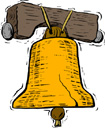The Declaration of Independence: Cry for Freedom
 The
Declaration of Independence was a desperate cry for freedom.
The British colonists living in America had grown used to
being their own bosses in many ways. They thought that the
British Parliament and its King, George
III, were making
too many laws that took away too many of their
freedoms. The
Declaration of Independence was a desperate cry for freedom.
The British colonists living in America had grown used to
being their own bosses in many ways. They thought that the
British Parliament and its King, George
III, were making
too many laws that took away too many of their
freedoms.
Some examples of these are the Stamp Act and the Sugar Act. Both put very high taxes on things that the American colonists used every day: paper and sugar. The Americans hadn't voted for these taxes. They hadn't even elected the members of Parliament who had passed the laws that created those taxes. To the Americans, this was "taxation without representation." They thought they had no say in what their government did to them. People who lived in Britain could protest and even choose not to re-elect lawmakers who voted for such taxes. But the Americans didn't have that option. They had to accept the taxes.
But the Intolerable Acts had the opposite effect. American colonists everywhere were angry. The following months saw the first meeting of the Continental Congress. Among other things, this group of delegates from all 13 colonies wanted to boycott British goods throughout the colonies. Not even a year later, the Revolutionary War had begun.
On June 28, the committee presented the Declaration to the Continental Congress. After a series of debates, the Congress approved it. On July 4, John Hancock, president of the Congress, signed it. The document itself was not signed by all 56 signers until much later. But Congress declared it in effect on July 4. This was in the middle of a war, of course. The Americans had forced the British to leave Boston, but many bad losses were to follow. The Americans had to fight long and hard to keep their independence. Still, the signing of that document gave them all a common cause, something they could fight for and defend with their very lives. |
|
Social Studies for Kids
copyright 2002–2025
David White

 Or
so Britain thought. The Americans weren't about to accept
such high taxes. Each new Act brought more outrage in
America. In one serious set of acts, which the Americans
called the
Or
so Britain thought. The Americans weren't about to accept
such high taxes. Each new Act brought more outrage in
America. In one serious set of acts, which the Americans
called the  The
Battles of
The
Battles of  Early
in 1776, while the troops were fighting in the field, more
delegates were meeting in Philadelphia, at the Second
Continental Congress. This Congress went on for months, and
out of it came the Declaration of Independence. The American
people had had enough. The delegates decided that they
wanted to declare themselves independent from Great Britain.
They appointed a committee of five people to write a
document to that effect. Those five people were
Early
in 1776, while the troops were fighting in the field, more
delegates were meeting in Philadelphia, at the Second
Continental Congress. This Congress went on for months, and
out of it came the Declaration of Independence. The American
people had had enough. The delegates decided that they
wanted to declare themselves independent from Great Britain.
They appointed a committee of five people to write a
document to that effect. Those five people were

